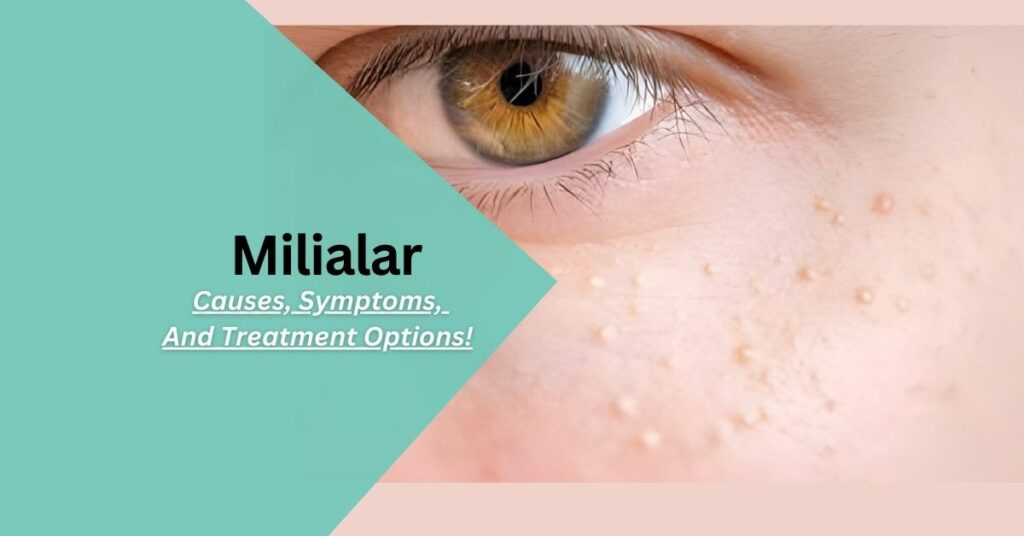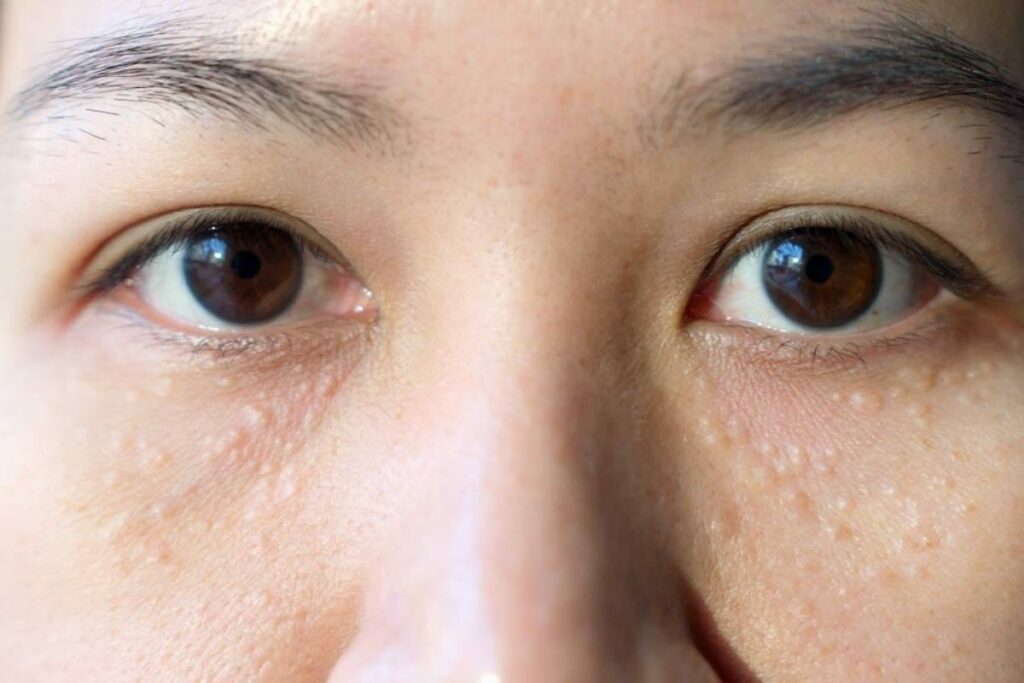Milialar – Causes, Symptoms, And Treatment Options!

Milialar, also known as milia, are tiny cysts that form just under the skin’s surface. They’re usually white or yellowish and can show up on your face or elsewhere on your body.
Milialar, also called milia, are tiny cysts under your skin. They look white or yellow and can pop up on your face or body. They happen when dead skin cells get stuck, and they might stick around longer as you get older or use certain skincare.
Learning about what causes them and how to deal with them can help you keep your skin healthy.
What Is Milialar? – Learn More About It!
Just Like, Tiny bumps hiding just under your skin’s surface. They’re called milialar. These bumps can be really small and feel hard. Sometimes, they’re white or yellowish. They happen when stuff like dead skin cells or even bits of hair get trapped under your skin.
Milialar likes to pop up on your face most of the time, especially around your eyes, cheeks, and nose. While they’re not dangerous and don’t hurt, they can bug you, especially if they’re where everyone can see.
Must Check: Duke Kenneth Fluent – Explore With Me!
Why Milialar Matters? – Impact On Skin Health!
- Cosmetic Concerns: Imagine you’ve got these little bumps on your face. It might make you feel a bit weird about how your skin looks. Feeling awkward about your skin can make you feel less confident.
- Skin Texture: Touch your skin. Does it feel smooth? If you’ve got milialar, it might feel rough or bumpy. These bumps can mess with how soft and smooth your skin feels.
- Potential Problems: Here’s the thing: if you try to get rid of these bumps by yourself, you could end up with scars or even make things worse. It’s better to let someone who knows what they’re doing handle it.
- Underlying Skin Stuff: Sometimes, having milialar can mean there’s something else going on with your skin. You may not be taking care of it right, or there might be other things making your skin act up. Understanding what’s causing these bumps can help you keep your skin happy and healthy.
Take Analysis To: What Is Urge Delivery – Check In 2024!
Types Of Milialar – Find Out More!
1. Vulval Milial Cysts:
- Vulval milial cysts are those little bumps that can appear around the outer part of a woman’s private area.
- These bumps feel like tiny lumps under the skin and might be white or yellowish.
- They can sometimes cause discomfort or worry, especially if they’re noticeable or if there’s more than one.
- Things like not cleaning well, changes in hormones, or even rubbing against clothes might cause these bumps to show up.
2. Vulvar Milial Cysts:
- Similar to the bumps in the vulval area, vulvar milial cysts are found around the lips of the female private area.
- They can be small and firm, feeling like little balls under the skin.
- Sometimes, they’re white or yellowish, and they might make someone feel self-conscious.
- These bumps might come up because of not washing properly, changes in hormones, or if the skin gets irritated.
3. Milial Cyst:
- A milial cyst is a general term for any little lump under the skin caused by dead skin cells getting trapped.
- They can pop up anywhere on the body, like the face, neck, chest, back, or even down below.
- Usually, they’re small and round, and they might be white, yellow, or the same colour as the skin.
- These cysts don’t usually hurt, but they can bother someone if they’re big or if there are lots of them.
- Sometimes, they’re there because old skin cells didn’t fall off like they should, and they got stuck under the skin.
You Also Have To Check: Elijah Spader – Who Is He!
Causes Of Milialar – Discover More!
1. Trapped Dead Skin Cells:
Milialar happens when dead skin cells get stuck under the skin instead of falling off like they should. Normally, our skin naturally gets rid of dead cells, but with milialar, they stick around and form small bumps under the skin. These bumps are filled with a protein called keratin and can look white or yellow.
2. Factors Contributing to Milialar:
Several things can make milialar more likely to happen:
- Getting Older: As we get older, our skin doesn’t shed dead cells as well, which can lead to more buildup and a higher chance of milialar.
- Using Certain Skincare Products: Some skincare products, especially oily ones, can clog pores and keep dead skin cells trapped, causing milialar.
- Having Skin Issues: People with conditions like rosacea or dandruff may be more prone to milialar because these conditions can mess up the skin’s shedding process.
- Sun Damage: Spending too much time in the sun can harm the skin and make it harder for dead cells to shed properly, increasing the risk of milialar.
- Family History: Sometimes, milialar runs in families, so if your relatives have it, you might be more likely to get it too.

Symptoms Of Milialar – Stay With Us!
Visual Appearance of Milialar:
Milialar looks like tiny raised bumps on the skin. They’re often white or yellowish and feel firm when you touch them. You might see them on your face, especially near your eyes, cheeks, nose, and eyelids. Sometimes, they can appear on other parts of your body, too. These bumps might bother you because they’re noticeable, especially on your face.
Sensory Symptoms:
Milialar usually doesn’t cause any pain, itching, or other uncomfortable feelings. You might only notice them if you look closely at your skin. However, even though they don’t hurt, having milialar bumps might make you feel unhappy about how your skin looks. It’s normal to feel self-conscious about them, even though they’re not physically uncomfortable.
Never Miss: Which Is True Of Inducements In Research – Get Motivation Here!
Diagnosis Of Milialar – Read More!
Clinical Evaluation:
Clinical evaluation means the doctor checks your skin to see if you have milialar. They look at the small bumps and feel your skin to make sure. They might ask if the bumps itch or hurt to help figure out what’s going on. This helps them decide what treatment they might need.
Differential Diagnosis:
Differential diagnosis is when the doctor compares your symptoms to other skin problems to make sure they know what you have. They check if your bumps look like other things, like acne or whiteheads. This helps them be sure they’re giving you the right treatment for your skin.
You Also Have To Check: ILikeComox – Your Ultimate Insider’s 2024 Guide!
Treatment Options For Milialar – Getting More Information!
1. Conservative Management:
Conservative Management means using gentle methods to help milialar go away on their own or stop them from getting worse. Here’s how it works:
- Observation and Monitoring: Sometimes, just keeping an eye on milialar without doing anything can be enough. Doctors will watch them closely to see if they change.
- Skincare Practices: Using mild soap and moisturizer can help keep the skin clean and healthy, which might prevent more milialar from forming.
- Sun Protection: Protecting the skin from the sun by wearing sunscreen and covering up can help prevent milialar from getting worse.
2. Medical Interventions:
Medical interventions are treatments that doctors do to manage milialar actively. Here are some common ones:
- Extraction Procedures: Doctors can use a special tool to remove milialar from the skin. This should only be done by trained professionals to avoid hurting the skin.
- Chemical Peels: Putting a special solution on the skin can help remove dead skin cells and make milialar less noticeable.
- Topical Retinoids: These are creams or gels that contain a special ingredient that helps the skin shed old cells. They can help improve milialar over time.
3. Surgical Options:
Surgical options involve more serious treatments done by doctors to remove milialar. Here’s what they might do:
- Electrosurgery: Using a special tool that uses electricity, doctors can remove milialar. It’s usually done with numbing medicine, so it doesn’t hurt much.
- Laser Therapy: Using a powerful beam of light, doctors can target and remove milialar. This can be a good option for bigger or stubborn milialar.
- Incision and Drainage: If milialar are big or won’t go away, doctors might need to make a small cut to drain them. Then they’ll take out the milialar to help the skin heal.
You have to Read: Geekzilla Tech Honor Magic 5 Pro – A Comprehensive Review!
Home Remedies And Self-Care For Milialar – Explore It!
Milialar is a skin condition that can often be managed with simple remedies and self-care. These easy steps can help you take care of your skin and make milialar less noticeable or bothersome.
Safe Home Practices:
- Keep It Clean: Wash your face gently with a mild soap or cleanser twice a day to keep the affected area clean. Avoid scrubbing too hard, as it can make milialar worse.
- Stay Moisturized: Use a moisturizer that won’t clog your pores to keep your skin hydrated. Apply it after washing your face to help lock in moisture.
- Choose Gentle Products: Use skincare products that are gentle and made for sensitive skin. Avoid products with heavy oils or strong chemicals that can make milialar worse.
- Protect Your Skin: Wear sunscreen every day to protect your skin from the sun’s harmful rays. Use a broad-spectrum sunscreen with SPF 30 or higher and wear protective clothing when you’re outside.
- Stay Healthy:
- Get enough sleep.
- Eat a balanced diet.
- Drink plenty of water to keep your skin healthy.
- These habits can help prevent milialar and keep your skin looking its best.
Also Check: Linuxia – The Open-Source Revolution!
Over-the-Counter Solutions:
If you want to try over-the-counter products for milialar, here are some options:
- Gentle Cleansers: Use a mild cleanser with ingredients like salicylic acid or alpha hydroxy acids to exfoliate your skin and unclog pores gently.
- Retinoid Creams: These creams can help speed up skin cell turnover and prevent milialar from forming. Apply them once a day after cleansing your skin.
- Spot Treatments: Spot treatments with ingredients like benzoyl peroxide or sulfur can help reduce inflammation and improve the appearance of milialar.
- Oil-Free Moisturizers: Look for moisturizers that won’t clog your pores, and use them regularly to keep your skin hydrated.
Frequently Asked Questions:
Are milialar cysts harmful?
Milialar cysts don’t usually hurt or cause any health problems, but they can be annoying because they’re hard to hide.
How can I treat milialar at home?
You can try things like washing your face gently, using moisturizer, and avoiding harsh skincare products. Over-the-counter creams can help, too.
When should I see a doctor about milialar?
If your milialar sticks around or bothers you, or if you’re not sure what’s going on with your skin, it’s a good idea to see a doctor. They can tell you what’s going on and help you figure out the best way to treat it.
Can milialar be prevented?
You can’t always stop milialar from happening, but being gentle with your skin and avoiding harsh products can help. Taking care of your skin and getting help if you need it can keep milialar from becoming a bigger problem.
Conclusion:
Milialar are tiny bumps under your skin. They’re usually not a big deal. Knowing what causes them and how to deal with them can help you keep your skin healthy. Just be gentle with your skin and ask a doctor if you need help.







